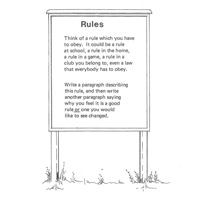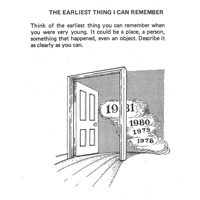You are here
APU History
Introduction
The Assessment of Performance Unit (APU) was created within the Department of Education and Science (DES) in 1975. Its main aims were to “promote the development of methods of assessing and monitoring the achievement of children at school, and to seek to identify the incidents of under‑achievement” (APU Terms of Reference; quoted in Foxman et al. 1991: 8).
The Unit subsequently commissioned Surveys of Attainment in five curriculum areas: Science, Mathematics, Language, Foreign Languages and Design & Technology. The APU corpus created in this project is based on a sample of the Language Performance Surveys; more specifically, on their Writing and Reading components (see below).
The APU Language Surveys (1979-1988)
In line with the other four key curriculum areas, the APU surveys of language performance were carried out in two phases: (i) on annual basis from 1979 to 1983, and (ii) in 1988.
All surveys involved representative groups of pupils aged 11 (Primary Surveys) and 15 (Secondary Surveys), as these age-groups are “the final years of primary and secondary statutory schooling respectively” (Foxman et al. 1991: 8). The Unit also ensured the balanced distribution of the surveys in schools and areas in England, Wales and Northern Ireland. Pupils were ‘chosen’ following the light sampling method (Lawton 1980: 59). Reports were published usually in the forms of booklets (1981‑1984, 1988), and leaflets were distributed, freely, to schools for the use of teachers (although one of the main failures of the Unit was precisely to raise interest in the teaching community; see e.g. Gipps & Goldstein 1983: 136-137).
The Language Performance Assessment Frameworks covered four key components: writing, reading, speaking, listening and (from 1982 onwards) oracy. Attitudes to each component were also integrated in the questionnaires at different stages. In addition, some (randomly selected) pupils were asked to submit a ‘work sampling’ component written “under normal classroom conditions”, which had to be completed in the weeks preceding the APU tests. (See further details in White 1986; Gorman 1986: 15-23; Gorman et al. 1991: 12-14, 29-53.)
All in all, from 1979 to 1988, the APU language surveys involved 43 large-scale surveys and some other 76 exercises (e.g. pilot tests), with a total of 616,802 pupils (Foxman et al. 1991: 101).
The writing and reading language surveys: an outline
The APU corpus developed in this project is based on the APU Writing and Reading Primary Language Surveys from the first and the last year of the APU Surveys (1979 and 1988).
In line with the educational trends of the time, the APU’s language team believed in approaching the study of language from a functional perspective (Stubbs 1986: 29; Hudson 2003). More specifically, the assumptions underlying the language assessment framework were mainly that (a) language is a purposeful activity, (b) that performance and attitudes are inter-related, and (c) that assessment should be focused not only on what is said but also on how it is said (see further Gorman 1986: 2-4; Foxman et al. 1991: 28-31). The overall aim was therefore to develop tasks “related as closely as possible to ways in which language is actually used” in their daily life (Thornton 1987: 2; also White 1986: 1).
In keeping with these ideas, the Reading surveys targeted the exploration of the different types of meaning conveyed through language; e.g. the actual ideas expressed in texts (propositional meaning); the emotive connotation of what is said (interpersonal meaning) and the non-literal, “implicated” meaning of language in context (pragmatic meaning). The range of materials pupils were asked to respond included works of reference (e.g. charts, diagrams, maps or tables), and works of literature and what the APU language team defined as ”readings for practical purposes in daily life” (e.g. periodicals, newspapers, classified adverts sets of instructions). A point that the APU Reading assessors were keen to emphasise was that difficulties in interpretation of a text do not only depend on the linguistic complexity of the text itself, but also on the specific purposes for which the text is being read.
As was the case in Reading assessment, the Writing surveys were based on a range of tasks that reflected the “purposes and uses for which pupils produced writing” (Gorman 1986: 15). Twelve main functions of language were therefore considered for the creation of the written tasks:
To describe/observe; to record/report; to plan/speculate; to narrate; to instruct/direct; to argue/persuade; to evaluate/review evidence; to correspond/request; to explain/reflect; to respond imaginatively/express feelings; to reason; to edit. (Gorman 1986: 15-16)
These functions were distributed across a range of ‘shorter’ and ‘longer’ task — each pupil being asked to write two extended pieces of writing and one shorter task (involving editing or making notes on a ready-available written text, integrating writing and diagrams/pictures or formulating testable propositions).
Writing Surveys
 |
 |
 |
Reading Surveys
 |
 |
 |
References mentioned in this section
Foxman, Derek D., Dougal Hutchinson & Barbara Bloomfield. 1991. 1240200 (Great Britain. Department of Education and Science. Assessment of Performance Unit). [London]: School Examinations and Assessment Council [SEAC EMU].
Gipps, Caroline & Harvey Goldstein. 1983. Monitoring children: An evaluation of the Assessment of Performance Unit (Great Britain. Department of Education and Science. Assessment of Performance Unit History). London: Heinemann Educational.
Gorman, Tom. 1986. The framework for the assessment of language (Great Britain. Department of Education and Science. Assessment of Performance Unit). Windsor: NFER-NELSON (for) the Assessment of Performance Unit.
Gorman, Tom, Janet White, Greg Brooks & Fiona English. 1991. Language for learning: A summary report on the 1988 APU surveys of language performance, vol. Assessment matters; no.4 (Great Britain. Department of Education and Science. Assessment of Performance Unit.). [London]: School Examinations and Assessment Council. Evaluation and Monitoring Unit [SEAC EMU].
Lawton, Denis. 1980. The politics of the school curriculum (Routledge Education Books). London: Routledge and Kegan Paul.
Thornton, Geoffrey. 1987. Language testing, 1979-1983: An independent appraisal of the findings (Great Britain. Department of Education and Science. Assessment of Performance Unit). London: H.M.S.O.
White, Janet. 1986. The assessment of writing. Pupils aged 11 and 15 (Great Britain. Department of Education and Science. Assessment of Performance Unit). Windsor: NFER-NELSON (for) the Assessment of Performance Unit.
























